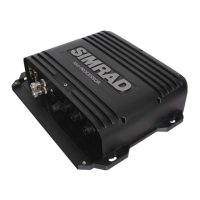| 67
StructureMap | NSO-II Operator Manual
StructureMap sources
Two sources can be used to overlay Structure logs on the charts;
- Live data, used when StructureScan units are connected to the NSO-II system
- Saved les. These are recorded StructureScan (*.sl2) data that are converted to
StructureMap (*smf) format. Saved *.smf les can be used onNSO-II units even if no
StructureScan units are connected.
Live source
When live data is selected the SideScan imaging history is displayed as a trail behind the
vessel icon. The length of this trail will vary depending on available memory in the unit
and range settings. As the memory lls up the oldest data will automatically be deleted as
new data is added. When increasing the search range the ping speed of the StructureScan
transducer is reduced, but the width and the length of the image history will be increased.
¼ Note: Live mode does not save any data. If the unit is turned o, all recent data is lost.
Saved les
When Saved les are selected, the StructureMap le is overlaid on the map based on
position information in the le.
If the chart scale is large, the StructureMap area will be indicated with a boundary box
until the scale is large enough to show Structure details.
Saved mode is used to review and examine StructureMap les, and to position the vessel
on specic points of interest on a previous scanned area.
¼ Note: When saved les are used as source, the NSO-II displays all StructureMap les found
on the SD card and in the system’s internal memory. If there is more than one Structure-
Map of the same area, the images will overlap and clutter the chart. If several logs of the
same area are required, the maps should be put on separate SD cards.
StructureMap tips
- To get a picture of taller structure (a wreck, etc) — don’t drive over it. Steer the boat so
the structure will be on the left or right side of your boat
- Don’t use Autorange when using SideScan. Set your structure range to a signicantly
greater level (two-to-three times) than the water depth to ensure a complete scan and
to maximize conversion accuracy
- Don’t overlap history trails when conducting a side-by-side scan of an area

